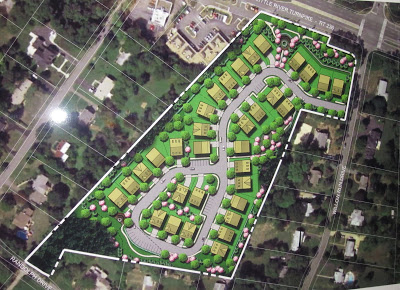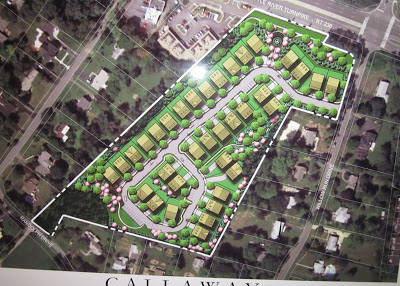Mason land use committee sides with residents’ concerns on infill development
 |
| The revised plan for the Campbell and Ferrera property |
The people spoke and the Mason District Land Use Committee (MDLUC) listened. After dozens of people offered impassioned pleas to reject infill development and protect the character of established neighborhoods, the committee agreed Feb. 28 not to urge the Fairfax County Planning Commission to approve proposals for higher-density projects at the Peace Valley Lane and Campbell and Ferrara properties.
The Peace Valley Lane proposal called for an amendment to the Fairfax County Comprehensive Plan as the first step in rezoning a 1.89-acre property in the Ravenwood Park neighborhood to permit up to eight houses.
The Fairfax County Planning Commission had earlier deferred a decision on the Peace Valley Lane proposal. It is now scheduled to vote on it March 8, and it will go to the Board of Supervisors on March 20. The MDLUC deferred action on both proposals at its last meeting in January.
“Please do not push this amendment forward. The residents do not want this,” Ravenwood Park Citizens Association Co-President Carol Turner told the MDLUC just before the vote last night.
When MDLUC Chair Roy Lounsbury asked his colleagues to vote on the issue, two voted to recommend that the Fairfax County Planning Commission amend the plan, and three voted to reject it. Lounsbury then said he would vote to oppose it, noting that is what the community wants. “I like the idea of a continuously zoned community,” he said. The split decision means the committee is not taking a position on the plan amendment.
“I am surprised and gratified that the land use committee was so receptive to the interests of the community,” said Ravenwood Park’s other co-president, John Iekel.
There is no guarantee that the Planning Commission will follow MDLUC’s lead, though. In fact, the commission usually goes along with the recommendation of the commissioner who represents the district where a proposed project is located, and Mason District’s representative on the commission, Janet Hall, supports the plan amendment.
Before the vote, Lounsbury told the audience that if the plan amendment to allow higher density is approved, neighborhood residents will have an opportunity to influence the design—for example, by requesting a wider buffer, more trees, more open space, and better stormwater management. If the zoning is not changed, the developer could build five houses “by right,” which means the community would not have input, he said. The property is currently zoned R-3, which allows three houses per acre.
A couple of people who live adjacent to the property were amenable to the prospect of amending the plan and gaining some leverage with the developer. Pat Hoar, for example, said if the plan amendment is done right, the new development would be shielded from existing houses and mature trees could be saved.
The vast majority of the residents of Ravenwood Park and nearby townhouse developments, however, preferred retaining the current zoning designation. “We believe R-3 maintains the stability of the neighborhood,” said Iekel. “Our ultimate concern is controlling density.”
Several residents raised issues with stormwater runoff and the possibility of opening up Peace Valley Lane to through traffic. Hall assured the audience that she will oppose attempts to extend that road.
After the Planning Commission discussed the proposal last month, Hall had asked Department of Planning and Zoning staff to come up with a revised recommendation on the property. The modified staff report calls for a maximum of seven houses, rather than eight, and says they should be positioned in the middle of the property to provide an expanded buffer and preserve more trees, said planner Clara Johnson.
One resident noted that land use decisions are critical because once a property is developed, it is permanent. A plan to build a handful of houses might seem minimal, but “if it happens all over Mason District, it is significant,” said another resident. “It’s the camel’s nose under the tent.”
 |
| The original plan for the Campbell and Ferrera site |
The other infill proposal considered by the MDLUC involves a proposal for 35 single-family houses on an 8.79-acre property on Little River Turnpike now occupied by the Campbell and Ferrara nursery. The developer, Stanley Martin Homes, is seeking a rezoning change from R-2 to PDH-4.
PDH (planned development housing) zoning allows greater density in return for an innovative design and calls for the creation of a homeowners association to have control over common areas, including stormwater management.
Following a discussion of that proposal, during which residents of the Willow Run community raised many objections about excessive density, stormwater runoff, and traffic, Lounsbury said: “I hear your message loud and clear. You want to keep R-2. You don’t want to destroy the character of your neighborhood.”
“I haven’t heard anything compelling me to increase the zoning,” said MDLUC member Jim Councilor, who offered a motion to deny the rezoning request and leave the R-2 zoning in place. The motion passed unanimously. The Planning Commission will consider the proposal March 8.
Jack Haberle, president of the Willow Run Civic Association, said he was “somewhat surprised” by the vote and is happy with MDLUC’s decision. Having so many people come to meetings—including some who stayed at a Planning Commission hearing Feb. 23 until 2 a.m.—“made all the differensce,” he said.
At that hearing, the Planning Commission deferred a vote on the rezoning request and asked the developer to submit a revised plan to the MDLUC.
Gregory Riegle, an attorney who represents the developer, presented a drawing at the MDLUC meeting showing some minor modifications to address residents’ concerns: There would be 33 houses rather than 35. A long, straight row of 13 houses would be broken up somewhat, and the orientation of some of the houses would change.
“There is nothing that is innovative in that design that would warrant a PDH designation,” one resident responded. “What in that drawing maintains the character of our neighborhood? I don’t see it,” said another resident.
Haberle called the modified plan “a slap in the face” to the community, noting “the original concerns are still there.” Other people complained that having Willow Run Drive as the only access point to the new houses would create unsafe conditions and the proposed underground stormwater system would be unsafe and difficult for an HOA to manage. One resident complained that the developer’s proposal for stormwater management is biased and called for an independent hydrology assessment.
“This plan is motivated by money—nothing else,” another resident said. “We put forward so many objections. We are concerned about the quality of our neighborhood. What we have here is so precious and rare. It is shameful to allow greedy developers to go forward.” She urged her neighbors “to remember why we are here and what we are fighting for.”


Good job all citizens!
It is horrifying to see the graphic for the proposed 35-house development plan presented by Stanley Martin Developers. The residents in Willow Run Homeowners Association never expected this result when the Plan Amendment to develop the Campbell and Ferrara property was rushed through the Planning Commission and Board of Supervisors in December 2011.
The developers do not live in these neighborhoods; in fact the developer/owner of the Peace Valley property lives and has his business in Bethesda, Maryland, so profits from these developments don’t even stay in Virginia. It must be common knowledge among developers that Mason District is open for high density infill developments, even if they are placed right in the middle of 60-year old established communities.
It all starts with our Supervisor Penny Gross. She is intolerant to any other viewpoint other than her own. She wants this and so she will push it forward no matter that her constituents do want it and it's poor land use. The fact that a proposal such as Campbell and Ferrara ever got this far (the graphic looks like sardines in a can) is abysmal. Same goes for Peace Valley on a smaller scale. How infill development in Mason District and Fairfax continues to proceed in this fashion is a travesty and needs to be stopped.
Why does Penny want the high density plans, because of incrementally more taxes?
I attended several of the Peace Valley meetings, and did not find the time I spent useful, helpful, or encouraging. Glad something got done at the Feb. 23 mtg.
Dave Wright. Lafayette Park Condominium representative